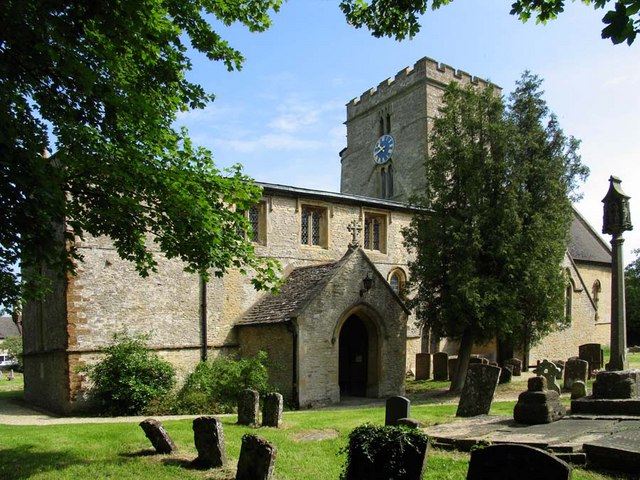Arthur Mee - The King's England, Oxfordshire.
Bucknell – The Great Tower.
 It has an 18th century gabled manor and a clerestoried Norman church overlooking a fine old cross, on which is carved the Crucifixion with Mary and John, and the Madonna with the Child. The great Norman tower, with a 15th century bell-chamber, battlements, and turret stairway, dominates the church, which has a 13th century doorway on the north, richly moulded with foliage capitals, and over its 13th century south doorway a charming and unusual new arch. Deeply recessed, it has three rows of delicate branch work between plain mouldings, and rests on clustered shafts with foliage which seems to be growing on the capitals.
It has an 18th century gabled manor and a clerestoried Norman church overlooking a fine old cross, on which is carved the Crucifixion with Mary and John, and the Madonna with the Child. The great Norman tower, with a 15th century bell-chamber, battlements, and turret stairway, dominates the church, which has a 13th century doorway on the north, richly moulded with foliage capitals, and over its 13th century south doorway a charming and unusual new arch. Deeply recessed, it has three rows of delicate branch work between plain mouldings, and rests on clustered shafts with foliage which seems to be growing on the capitals.
In the tower, which has a Norman arch, are built-up Norman doorways; and in the walls of the nave are two other Norman doorways open no more, each with a piscina. On the south wall are two mass dials from the days before clocks. A window glowing in red, green and gold has in it the Good Shepherd, another has Christ and the children, and in an aisle lancet is a red-winged Michael standing on a dragon and holding scales in which a man with a crucifix weighs down a demon. There is a Jacobean pulpit with classical pilasters between its panels.
W. Hobart Bird – Old Oxfordshire Churches.
The church is a perfect gem of Early English architecture. Dedicated to St. Peter it comprises quire, nave, central tower, and South porch. The tower has three stages. The lower are Norman, and the upper with Perpendicular parapet; the sound-holes have double lights with parts of round Norman arches within a plane masonry arch; the jamb-shafts and central pillars have cushion capitals with grooved abaci. There is a semi-circular turret on the North. The exterior of the tall West window is good Early English; it has a continuous chamfered inner order, slender jamb-shafts with stiff-stalk capitals, one order roll moulding and label with grotesque finials. The Early English stringcourse remains along the external walls. The modern porch is a most admirable addition, because it protects the very beautiful Early English doorway, which has triple jamb-shafts with typical stiff-stalk capitals and rounded abaci, the arch has a rounded inner order and curious interrupted chevrons, two orders of roll mouldings and hood-mould. This moulding continues along the walls. The North doorway is also good but simpler Early English, having detached jamb-shafts with stiff-stalk capitals, rounded abaci, a heavy continuous roll moulding and an arch of two orders of mouldings, and labels continued along walls.
The interior of the church is excellent – quite a rare example of unspoiled Early English. The quire is entirely of that style. On the East is a triplet of tall narrow lights within a splay, which is pointed and has a roll mould; the slender jamb-shafts have stiff-stalk capitals with roll mould and label. The outer order and label continue along the walls and above each window. There are three tall lancets North and South, and a priest’s door on South. Note the interesting old organ, also the contemporary Early English low-side window against the chancel arch.
The base of the tower has a round head Norman light on the North and three plain arches of that period with chamfered abaci. The nave clerestories are Perpendicular. There are Early English lights on the North and South, and the North and South doors are all connected by the continuous string below windows and above the doors. There is a tall Early English lancet in the West, similar in style to the East triplet. The North and South arches near the tower contain Decorated tracery window and piscina bows in the sills.
Note the very good design of the old oak pulpit, also part of the original mensa of the altar in the sanctuary. Within the South doorway note the good Early English holy-water stoup. The octagonal font is early Decorated. There are two mass-dials on the South wall.